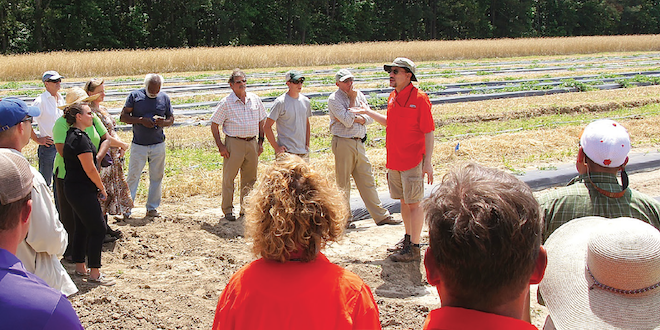
May 1, 2020Cantaloupe diseases present differently than in watermelon
Watermelon is the key cucurbit in South Carolina, but the Eastern-type cantaloupes grown for muskmelon are important, too, and both face immense pressure from foliar disease. The fungicide program for watermelon is well developed, but how well does it work for cantaloupe?
A new disease survey at Clemson University is trying to find out.
The survey’s first-year message is clear – weather still drives foliar disease.
June was hot and wet with temperatures consistently near 90˚ F and many areas getting close to 10 inches of rain, but it followed a May that was hot and dry with temperatures up to 100˚ F. That meant less gummy stem blight.

“We expected the incidence of gummy stem blight to be low because of the dry weather,” said Anthony Keinath, research and Extension pathologist in Clemson University’s Plant and Environmental Sciences Department.
Keinath spoke on the disease survey at the recent Ag Expo in Wilmington, North Carolina. Ag Expo is jointly presented by the North Carolina Vegetable Growers Association and the North Carolina Agribusiness Council.
Gummy stem blight, alternaria leaf blight, cercospora leaf spot, powdery mildew and phoma leaf spot were the most common diseases found.
The incidence of cercospora leaf spot was very common but at low levels. The same was true of phoma leaf spot, but phoma’s incidence was a bit of a surprise.
“Phoma was in lots of fields but at a low level,” Keinath said. “We expected low levels but not in that many fields.” Phoma is favored by hot, dry weather and is considered a weak pathogen on watermelon and cantaloupe.
Powdery mildew was only found in two fields but even that incidence of the disease was a surprise because the cantaloupe varieties grown in South Carolina are resistant. “We didn’t expect to find powdery mildew at all,” Keinath said, “but there are a lot of different races so you sometimes can find powdery mildew on resistant cantaloupe.” Powdery mildew is favored by dry weather and got an early start in 2019.
Alternaria leaf blight is primarily a disease of cantaloupe and not watermelon. It was found in higher incidences than expected – in about half of the fields surveyed. “I expected to find it,” Keinath said. “You see alternaria on cantaloupe, but rarely on watermelon.”
Rotation, row direction and the class of the fungicides used clearly affected the incidence of disease.
Rotation had a significant impact with good rotations having less disease. “We found that pretty clearly with alternaria,” Keinath said. The standard recommendation is only plant watermelon or cantaloupe no more frequently than once every third year.
Row alignment showed some surprising findings.
Fields with rows at right angles to the prevailing west winds had less disease. This was most likely from better air circulation and faster leaf drying after a rain or dew.
Aligning rows may not be a concept many growers can use. “It is something to consider when laying out a new field,” Keinath said. It may be a better fit for smaller or organic growers.
The incidence of alternaria will likely require a Group 11 fungicide to be added to the tank mix. “They are the most effective fungicides against Alternaria,” Keinath said. “These products aren’t used in watermelon because gummy stem blight, powdery mildew and downy mildew have become resistant.”
“This is where the cantaloupe program differs from the watermelon program,” Keinath said. “Most growers who have cantaloupe and watermelon will want to have one tank mix, but growers who’ve had a problem with alternaria are going to want to spray separately for it. Alternaria will reduce the sugar content of cantaloupe so it can also affect quality.”
The cantaloupe disease survey is a three-year study that will run through 2021. Only 11 growers’ fields were surveyed in 2019 but that number will increase. “Eleven fields are not enough to determine the most effective fungicide program,” Keinath said. “We’ll be surveying 40 fields by the end of the trial. At that stage, the most effective fungicides are going to stand out.”
— Dean Peterson, VGN correspondent; featured photo: Anthony Keinath leads a demonstration on vegetable cultivation at Clemson’s Coastal Research and Education Center in Charleston. Keinath was the 2018 recipient of the Godley-Snell Award for Excellence in Agricultural Research, Clemson’s highest agricultural research honor. Photos: Clemson University
















